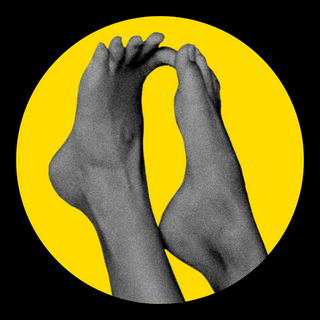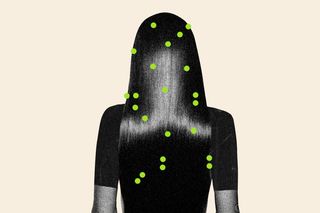
Hair Straightening Chemicals Were Linked With Cancer – Showing the Dangers of Beauty Norms Around Hair
Our cultural fixation on straight hair over curls is endangering women’s health by putting them at greater risk of uterine cancer.

“I [have been] shamed all my life for having curly hair. I was never chosen for lead roles in plays because princesses could not have hair like mine,” Elizabeth Alex, a curly-haired woman from Pune, recounted to The News Minute. One of the highlights of Mia’s “makeover” in the Hollywood classic, The Princess Diaries, was the straightening of her curly hair — suggesting that curly hair is “ugly” and needs to be tamed into straight tresses.
Alex’s experience isn’t isolated. During an online roundtable discussion, actor Fatima Sana Sheikh described an experience on the set of a TV show, where a 10-year-old girl with curls was made to feel bad about her hair, with stylists comparing her hair to a mop. Actor Nithya Menen, who was part of the same discussion and has curly hair herself, admitted to Sheikh’s account resonating with her first-hand experiences with stylists, too.
This tends to result in women resorting to hair straightening in order to be perceived as good-looking. “I recently went to a bachelorette party where the whole house smelled like burnt hair because all 14 of us spent 45 minutes each in front of the mirror burning our curls into submission,” Zarna Surti, a first-generation Indian-American who grew up in the U.S., wrote in Refinery29.
Despite the most common textures of Indian hair varying from slight waves to tight curls, pop culture perpetuates an unrealistic, unnatural, Euro-centric beauty standard. Doing so, undoubtedly, impacts the self-esteem — and, by extension, the mental health — of curly-haired women.
Society’s obsession with straight hair — perhaps, as a symptom of our colonial hangover — doesn’t just impact women’s self-worth, though; it also endangers their health. According to a recent study by the National Institutes of Health in the U.S., regular use of hair straightening products made women twice as likely to develop uterine cancer — compared to those who didn’t use the products. A 2019 study, too, found a disturbing link between the usage of chemical hair straighteners and a greater risk of breast cancer.
Related on The Swaddle:
Beauty Norm Rebellions in 2020 Redefined Beauty — But Didn’t Eliminate It
Yet, pop culture — including movies, advertisements, and magazines — ends up almost exclusively showcasing women with straight hair. “Most people I meet think Indian women have naturally straight, shiny hair. I get it, you’ve seen the photos of Bollywood stars, their strands billowing in slow motion across the screen,” Surti added.
It’s common knowledge that straightening one’s hair frequently can dehydrate it, make it prone to breakage, and result in split ends. This doesn’t deter women from braving it anyway — having been conditioned to associate their self-worth with their outward appearance, they often see it as a rather reasonable price to pay in order to look beautiful. But, as it turns out, the cost of adhering to beauty standards — by straightening one’s hair — can be malignant, too.
With hair straightening products being available over the counter, and salons offering heavy discounts on straightening services, the easy access draws people in, compounding the eventual health risk.
The new study also highlights how Black women are at a greater risk of the adverse effects of straightening since they end up using “hair straightening or relaxer products more frequently and… at earlier ages.” With curly hair often being an “otherizing” element — particularly in countries with largely white populations — their need to “fit in” by changing the way they look is but natural. Growing up in Nashville, U.S., Surti, too, found herself at the receiving end of comments that bordered on bullying her for her hair texture. She recalls being regularly called “poofhouse” and “frizz queen.” As a result, like many women of color, “I spent most of my life trying to make my hair something it wasn’t.”
Indians aren’t vastly different in their derision toward non-straight hair either. According to an India-based survey, more than 70% of our population finds curly hair less attractive than long, straight hair. “The results echo a stereotype mindset that is unhealthy and weighs down the choices for Indian women. It is stressful for women to be judged by [their] type of hair before they even enter the room,” it noted.
Related on The Swaddle:
India’s Miss Universe Victory Shouldn’t Take Away Focus From Beauty Contests’ Toxic Culture
“I was bullied in college because of my hair, called names like poodles and noodles,” says Angela Vaz, an illustrator. Her experience led her to subject her hair to chemical-based straightening treatments, and if not, simply chop it off. For curly-haired women, the only choices can’t be either cancer or a lifetime of poor self-esteem.
For years, Bollywood has glorified and sexualized long, straight hair through songs like Yeh Reshmi Zulfein (1969), Zara Zara (2001), and Yeh Hawaaein Zulfon Mein Teri (2001) — making hair an important part of a woman’s perceived attractiveness. Hardly coincidentally, most of these songs were also picturized on actors with long, straight hair — setting that as the standard for beautiful hair. Even shampoo ads in the 1990s and 2000s consistently hired models with straight hair.
At present, though, with actors like Menen refusing to “tame” her natural curls — alongside curly-haired actors like Taapsee Pannu and Mithila Palkar rising in prominence — people are gradually beginning to embrace their natural curls. With the “curly hair movement” and “curl pride” simultaneously gaining momentum, too, acceptance of curls is on the upswing for Indian women.
Following the present research that served as “the first epidemiologic study that examined the relationship between straightener use and uterine cancer,” its authors are planning to “identify the specific chemicals that may be increasing the risk of cancers in women.”
In the meantime, for those still trapped by society’s unfair standards of beauty, perhaps, this study will serve as a strong enough motivating force to steer away from cancer-causing chemicals — only if death doesn’t seem worth the promise of “fitting in,” of course.
Devrupa Rakshit is an Associate Editor at The Swaddle. She is a lawyer by education, a poet by accident, a painter by shaukh, and autistic by birth. You can find her on Instagram @devruparakshit.
Related


Birdsong Can Reduce Anxiety, Paranoia, New Study Suggests
